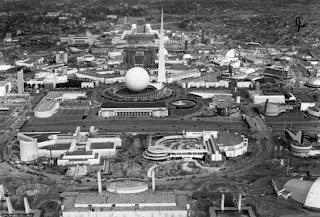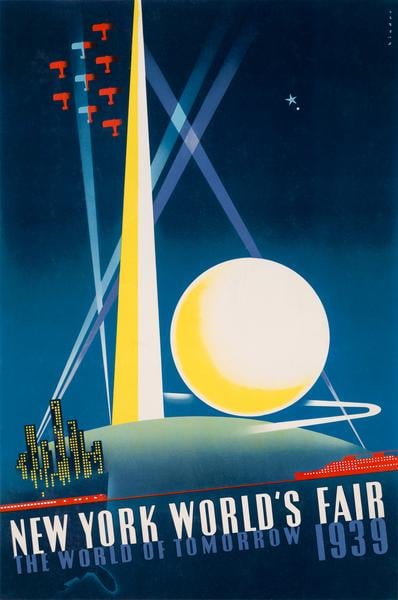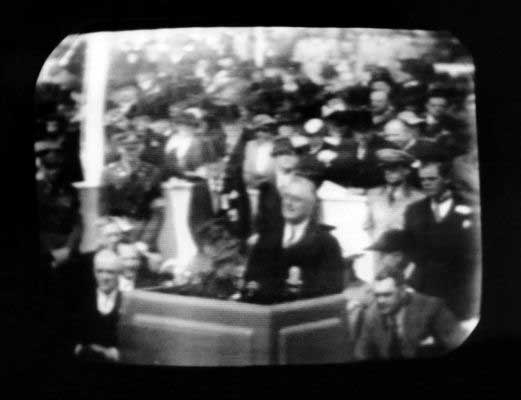April 30, 1939: The World of Tomorrow
April 30, 1939: The New York World's Fair opens in Flushing Meadow-Corona Park, in Queens. With a theme of "The World of Tomorrow," it remains the most celebrated of America's World's Fairs.
The Fair was heavily promoted: In the 1938 baseball season, all 3 of the City's Major League Baseball teams wore patches advertising it, a year ahead of schedule. Oddly, none of them kept the patch for the 1939 or '40 season. Instead, in 1939, every Major League Baseball team wore a patch honoring the 100th Anniversary of Abner Doubleday inventing baseball in Cooperstown, New York in 1939 -- which, of course, he didn't do, and this was already widely known.
The "Tomorrow" in question was 1960. Of course, since, as political columnist Jack Germond taught us, "The future is never a straight-line projection of the present," it was a 1960 with the Great Depression over, but with World War II not having happened.
President Franklin D. Roosevelt officially opened the fair. RCA Chairman David Sarnoff, who ran the NBC radio network, used the occasion to start the network's television service. There were only about 100 TV sets capable of receiving the signal, so the birth of television broadcasting as we know it is a bigger deal in hindsight than it was at the time.
Actual preserved TV image of FDR's speech
The centerpieces of the Fair were a 610-foot spire named the Trylon, and the 200-feet-in-diameter Perisphere. The latter was a "model city of tomorrow" where visitors could imagine what 1960 could look like.
The Fair was divided into Zones. The Communications and Business Systems Zone had major corporations putting their wares on display in "pavilions," including RCA, AT&T, IBM, General Motors, General Electric and Westinghouse. It also included a Masterpieces of Art building, with 300 works of art donated from around the world.
The General Motors Pavilion
The Community Interest Zone had "Demonstration Homes" of the future, an "Electrified Farm," and exhibits conducted by charitable groups such as the YMCA, the Christian Scientists, and the federal government's Works Progress Administration (WPA).
And the Government Zone had a Court of Peace, a Court of States, and a Lagoon of Nations. There were 60 pavilions on which various countries around the world displayed parts of their culture. Some of these were of nations that, at the least, pretended toward democracy, and some even gave it a good shot: Britain, France, Poland, Czechoslovakia, "Jewish Palestine," and "the Pan American Union."
The Fair was also the last gasp of the Art Deco movement.
Others were nations that seemed to flaunt their tyranny: Imperial Japan, Benito Mussolini's Fascist Italy, the fascist regime of Ioannis Metaxas in Greece, and the Soviet Union, then the only major nation practicing Communism. Nazi Germany did not send anyone, and wouldn't have been welcome in New York City, anyway.
There was a Food Zone, a Production and Distribution Zone, and a Transportation Zone. And there was an Amusement Zone, with rides like a parachute jump.
The Fair stayed open until October, by which point World War II had begun. It reopened the following April, without the Soviet Pavilion. The French, Polish and Czech Pavilions were basically the biggest remaining pieces of free life in those countries. The Fair closed for good on October 27, 1940. By that point, many of the exhibits' home countries had fallen under the Nazis' control.
Over 45 million people attended over the 2 years, a little less than the 48 million that attended the 1933-34 Century of Progress Fair in Chicago. Among the visitors, in June, were King George VI and Queen Elizabeth of Great Britain, during their North American tour that also included meeting President and Mrs. Roosevelt and a visit to Canada. They visited all the pavilions from places in the British Empire.
Demolition began on December 10, 1940, including the moving of several rides, including the parachute jump, to the Boardwalk at Coney Island in Brooklyn. Billy Rose's Aquacade, a small stadium built by Rose, a songwriter and theater impresario, for water stunt shows, remained standing, but derelict and a ground for homeless people and drug deals, until the 1990s.
Two buildings remain. The New York State Pavilion is now the Queens Museum, and contains many artifacts, including tickets and usher's uniforms. And the World's Fair Station of the Interborough Rapid Transit (IRT) system remains in use.
The 1964-65 New York World's Fair opened on the same location, and some of its structures remain, including the Unisphere, a huge globe that was built on the site of the Perisphere. Over its 2 years, 51 million people attended, still a record for a World's Fair. It opened 5 days after Shea Stadium opened across the street, and the World's Fair station was renamed "Willets Point-Shea Stadium." When Citi Field opened in 2009, as Shea's replacement, people upset over naming the ballpark after a bank in the midst of a recession largely caused by banks led the MTA to rename the station "Mets-Willets Point."
The "zone" concept would be adopted by Walt Disney, first for Disneyland in Anaheim, California in 1955, then for Walt Disney World outside Orlando, Florida, which opened after his death, in 1971. Both included a "Tomorrowland," a nod to New York 1939.
And many of the exhibits from the '64 Fair ended up at Disney World. I went there in 1986, and my parents, from Newark, New Jersey, kept pointing out things left over from "the New York World's Fair," at which they dated in 1965: My father was 22, and my mother was 18. My mother's mother was with us, and she was a native of Queens, and she kept telling us that 1939 was "the real World's Fair," because she had been there, at the age of 15.
Had any of them done their research, as I've done for this article, they would have known that the "Spaceship Earth," the centerpiece of Disney's EPCOT Center, was based on the '39 Perisphere and its "model city of tomorrow."
*
April 30, 1939 was a Sunday. Football, basketball and hockey were out of season. These games were played in what would later be called Major League Baseball:
* The New York Yankees lost to the Washington Senators, 3-2 at Yankee Stadium. Oral Hildebrand was cruising with a 1-0 lead after 7 innings, but he ran out of gas in the 8th. Joe DiMaggio was injured, and did not play. Lou Gehrig flew out to center in the 2nd, flew out to right in the 4th, grounded to 2nd in the 6th, and flew out to center in the 8th. He played the whole game at 1st base, and had 7 putouts and 2 assists. It was his 2,130th consecutive game.
He never played again: Two days later, in Detroit, he asked manager Joe McCarthy to take him out of the lineup "for the good of the team."
* The Brooklyn Dodgers beat the Philadelphia Phillies, 3-1 at Ebbets Field.
* The New York Giants lost to the Boston Bees, 3-2 at National League Park in Boston. Mel Ott went 1-for-3. This was the 4th of 5 seasons in which the former Boston Braves experimented with new names for themselves and their ballpark after a disastrous 1935 season. The new names never caught on, and the Boston Braves and Braves Field names were restored for 1941.
* The Boston Red Sox beat the Philadelphia Athletics, 3-1 at Shibe Park in Philadelphia. Pitcher Jim Bagby Jr. and Bobby Doerr hit home runs for the Red Sox. Jimmie Foxx went 1-for-3. Rookie sensation Ted Williams did not play.
* The Detroit Tigers beat the Cleveland Indians, 14-1 at Briggs Stadium in Detroit. (It was renamed Tiger Stadium in 1961.) Charlie Gehringer hit a home run, going for 4-for-5 with 5 RBIs. Hank Greenberg went 3-for-4 with 2 RBIs.
* The Chicago Cubs beat their arch-rivals, the St. Louis Cardinals, 4-1 at Wrigley Field in Chicago.
* And the Chicago White Sox, well, the St. Louis Browns weren't exactly their arch-rivals, but the White Sox won, anyway, 6-5 at Sportsman's Park in St. Louis.
* And the Cincinnati Reds and the Pittsburgh Pirates were rained out at Forbes Field in Pittsburgh. The game was made up as part of a doubleheader on September 6. The Pirates won the opener, 5-4, when Paul Waner singled home the winning run in the bottom of the 11th. The Reds won the nightcap, 4-3, when Billy Werber doubled home the winning run in the top of the 10th.











Comments
Post a Comment